HR and Financial Management Report: M&S Case Study Analysis
VerifiedAdded on 2022/12/28
|12
|2762
|85
Report
AI Summary
This report provides an in-depth analysis of Human Resource (HR) and Financial Management practices, using Mark & Spencer (M&S) as a case study. The HR section explores the role of HR in an organization, focusing on employee motivation and the application of motivational theories such as Herzberg's two-factor theory and Maslow's hierarchy of needs within the context of M&S. It examines how M&S utilizes various strategies, including bonuses and growth opportunities, to motivate its workforce. The financial management segment discusses the importance of financial planning, investment opportunities, and the role of a financial manager. It delves into the functions of financial managers, including profit planning, capital market analysis, and fund allocation, as well as the sources of finance for a business. The report emphasizes the interconnectedness of HR and financial strategies in achieving organizational goals, providing a comprehensive overview of key concepts and their practical application within the retail sector.
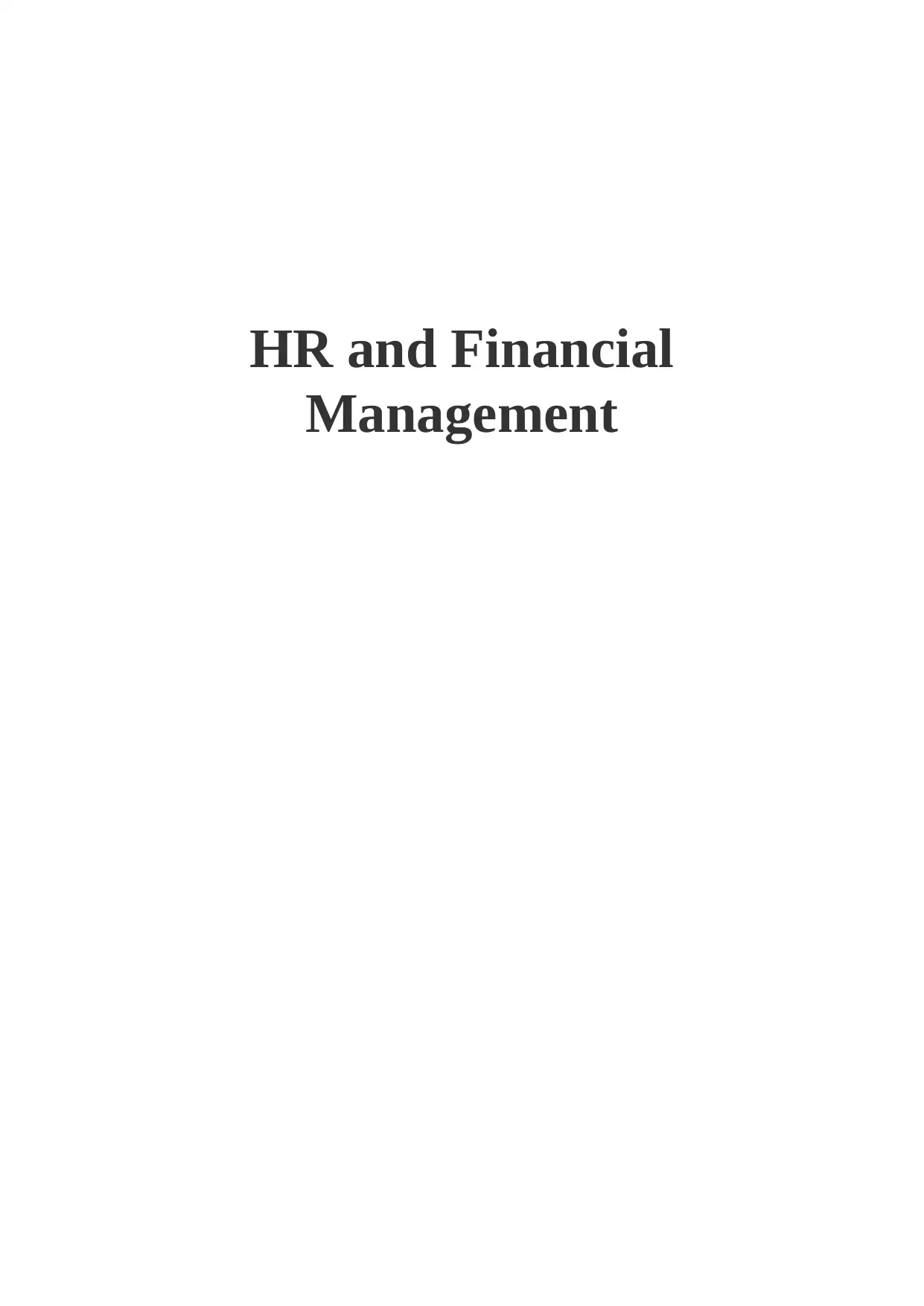
HR and Financial
Management
Management
Paraphrase This Document
Need a fresh take? Get an instant paraphrase of this document with our AI Paraphraser
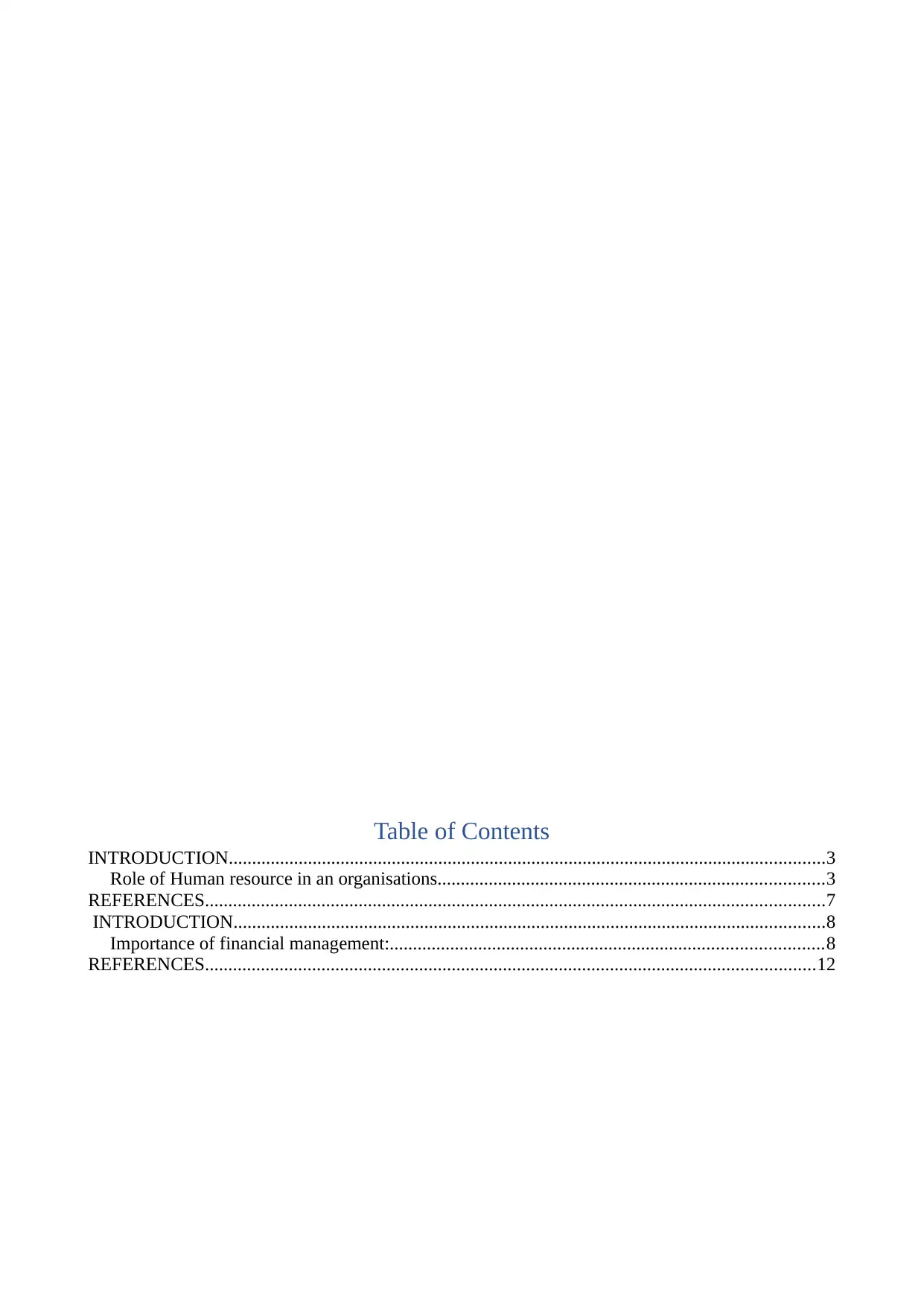
Table of Contents
INTRODUCTION................................................................................................................................3
Role of Human resource in an organisations...................................................................................3
REFERENCES.....................................................................................................................................7
INTRODUCTION...............................................................................................................................8
Importance of financial management:.............................................................................................8
REFERENCES...................................................................................................................................12
INTRODUCTION................................................................................................................................3
Role of Human resource in an organisations...................................................................................3
REFERENCES.....................................................................................................................................7
INTRODUCTION...............................................................................................................................8
Importance of financial management:.............................................................................................8
REFERENCES...................................................................................................................................12
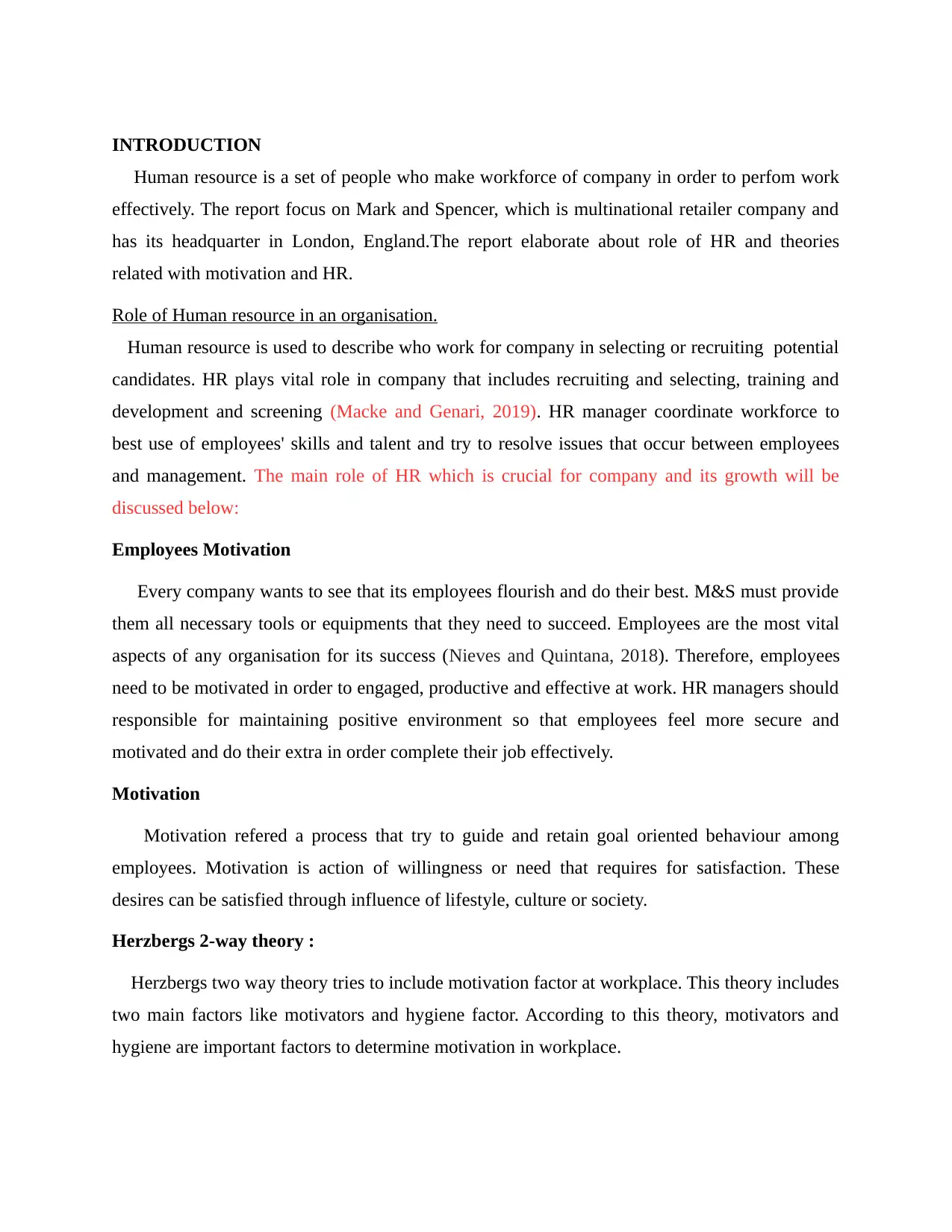
INTRODUCTION
Human resource is a set of people who make workforce of company in order to perfom work
effectively. The report focus on Mark and Spencer, which is multinational retailer company and
has its headquarter in London, England.The report elaborate about role of HR and theories
related with motivation and HR.
Role of Human resource in an organisation.
Human resource is used to describe who work for company in selecting or recruiting potential
candidates. HR plays vital role in company that includes recruiting and selecting, training and
development and screening (Macke and Genari, 2019). HR manager coordinate workforce to
best use of employees' skills and talent and try to resolve issues that occur between employees
and management. The main role of HR which is crucial for company and its growth will be
discussed below:
Employees Motivation
Every company wants to see that its employees flourish and do their best. M&S must provide
them all necessary tools or equipments that they need to succeed. Employees are the most vital
aspects of any organisation for its success (Nieves and Quintana, 2018). Therefore, employees
need to be motivated in order to engaged, productive and effective at work. HR managers should
responsible for maintaining positive environment so that employees feel more secure and
motivated and do their extra in order complete their job effectively.
Motivation
Motivation refered a process that try to guide and retain goal oriented behaviour among
employees. Motivation is action of willingness or need that requires for satisfaction. These
desires can be satisfied through influence of lifestyle, culture or society.
Herzbergs 2-way theory :
Herzbergs two way theory tries to include motivation factor at workplace. This theory includes
two main factors like motivators and hygiene factor. According to this theory, motivators and
hygiene are important factors to determine motivation in workplace.
Human resource is a set of people who make workforce of company in order to perfom work
effectively. The report focus on Mark and Spencer, which is multinational retailer company and
has its headquarter in London, England.The report elaborate about role of HR and theories
related with motivation and HR.
Role of Human resource in an organisation.
Human resource is used to describe who work for company in selecting or recruiting potential
candidates. HR plays vital role in company that includes recruiting and selecting, training and
development and screening (Macke and Genari, 2019). HR manager coordinate workforce to
best use of employees' skills and talent and try to resolve issues that occur between employees
and management. The main role of HR which is crucial for company and its growth will be
discussed below:
Employees Motivation
Every company wants to see that its employees flourish and do their best. M&S must provide
them all necessary tools or equipments that they need to succeed. Employees are the most vital
aspects of any organisation for its success (Nieves and Quintana, 2018). Therefore, employees
need to be motivated in order to engaged, productive and effective at work. HR managers should
responsible for maintaining positive environment so that employees feel more secure and
motivated and do their extra in order complete their job effectively.
Motivation
Motivation refered a process that try to guide and retain goal oriented behaviour among
employees. Motivation is action of willingness or need that requires for satisfaction. These
desires can be satisfied through influence of lifestyle, culture or society.
Herzbergs 2-way theory :
Herzbergs two way theory tries to include motivation factor at workplace. This theory includes
two main factors like motivators and hygiene factor. According to this theory, motivators and
hygiene are important factors to determine motivation in workplace.
⊘ This is a preview!⊘
Do you want full access?
Subscribe today to unlock all pages.

Trusted by 1+ million students worldwide
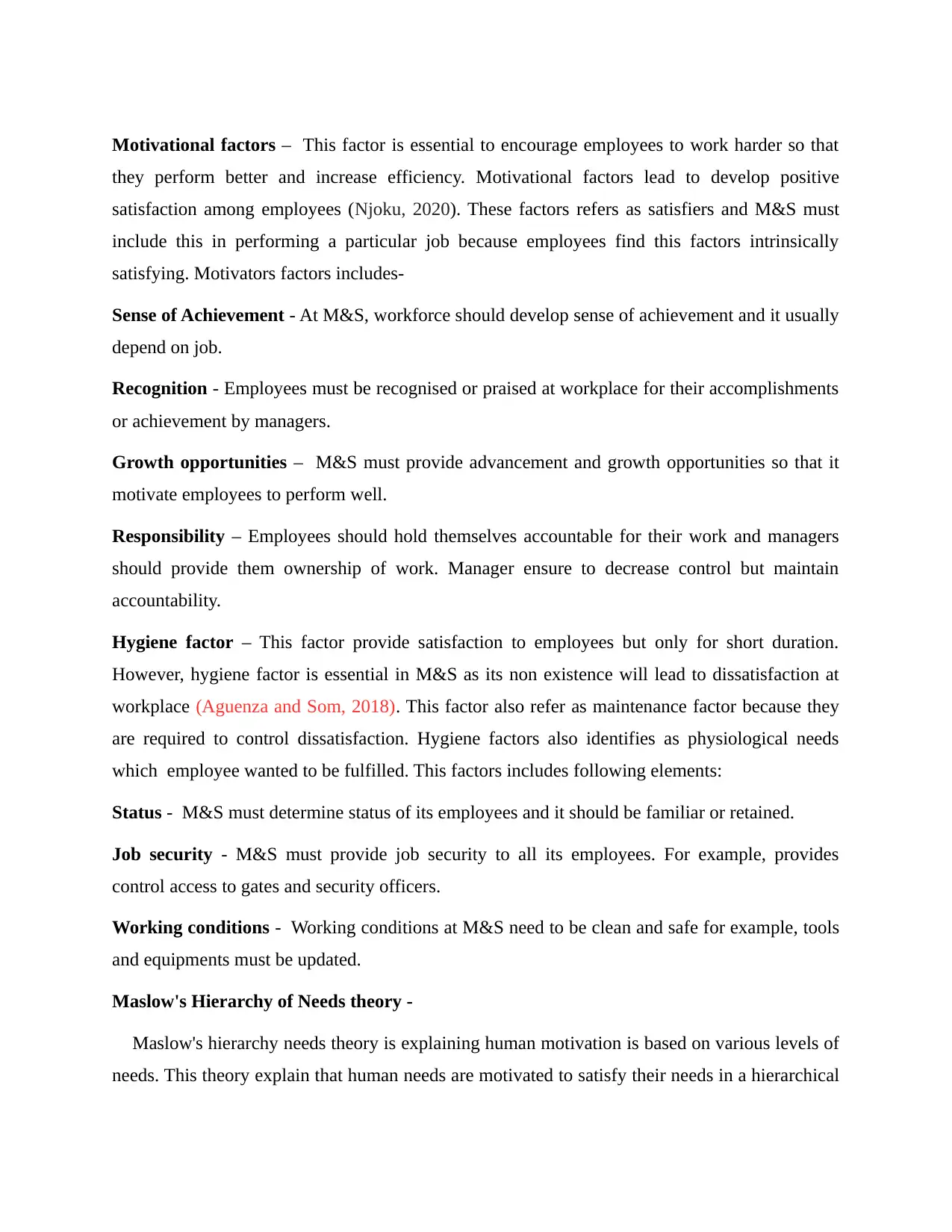
Motivational factors – This factor is essential to encourage employees to work harder so that
they perform better and increase efficiency. Motivational factors lead to develop positive
satisfaction among employees (Njoku, 2020). These factors refers as satisfiers and M&S must
include this in performing a particular job because employees find this factors intrinsically
satisfying. Motivators factors includes-
Sense of Achievement - At M&S, workforce should develop sense of achievement and it usually
depend on job.
Recognition - Employees must be recognised or praised at workplace for their accomplishments
or achievement by managers.
Growth opportunities – M&S must provide advancement and growth opportunities so that it
motivate employees to perform well.
Responsibility – Employees should hold themselves accountable for their work and managers
should provide them ownership of work. Manager ensure to decrease control but maintain
accountability.
Hygiene factor – This factor provide satisfaction to employees but only for short duration.
However, hygiene factor is essential in M&S as its non existence will lead to dissatisfaction at
workplace (Aguenza and Som, 2018). This factor also refer as maintenance factor because they
are required to control dissatisfaction. Hygiene factors also identifies as physiological needs
which employee wanted to be fulfilled. This factors includes following elements:
Status - M&S must determine status of its employees and it should be familiar or retained.
Job security - M&S must provide job security to all its employees. For example, provides
control access to gates and security officers.
Working conditions - Working conditions at M&S need to be clean and safe for example, tools
and equipments must be updated.
Maslow's Hierarchy of Needs theory -
Maslow's hierarchy needs theory is explaining human motivation is based on various levels of
needs. This theory explain that human needs are motivated to satisfy their needs in a hierarchical
they perform better and increase efficiency. Motivational factors lead to develop positive
satisfaction among employees (Njoku, 2020). These factors refers as satisfiers and M&S must
include this in performing a particular job because employees find this factors intrinsically
satisfying. Motivators factors includes-
Sense of Achievement - At M&S, workforce should develop sense of achievement and it usually
depend on job.
Recognition - Employees must be recognised or praised at workplace for their accomplishments
or achievement by managers.
Growth opportunities – M&S must provide advancement and growth opportunities so that it
motivate employees to perform well.
Responsibility – Employees should hold themselves accountable for their work and managers
should provide them ownership of work. Manager ensure to decrease control but maintain
accountability.
Hygiene factor – This factor provide satisfaction to employees but only for short duration.
However, hygiene factor is essential in M&S as its non existence will lead to dissatisfaction at
workplace (Aguenza and Som, 2018). This factor also refer as maintenance factor because they
are required to control dissatisfaction. Hygiene factors also identifies as physiological needs
which employee wanted to be fulfilled. This factors includes following elements:
Status - M&S must determine status of its employees and it should be familiar or retained.
Job security - M&S must provide job security to all its employees. For example, provides
control access to gates and security officers.
Working conditions - Working conditions at M&S need to be clean and safe for example, tools
and equipments must be updated.
Maslow's Hierarchy of Needs theory -
Maslow's hierarchy needs theory is explaining human motivation is based on various levels of
needs. This theory explain that human needs are motivated to satisfy their needs in a hierarchical
Paraphrase This Document
Need a fresh take? Get an instant paraphrase of this document with our AI Paraphraser
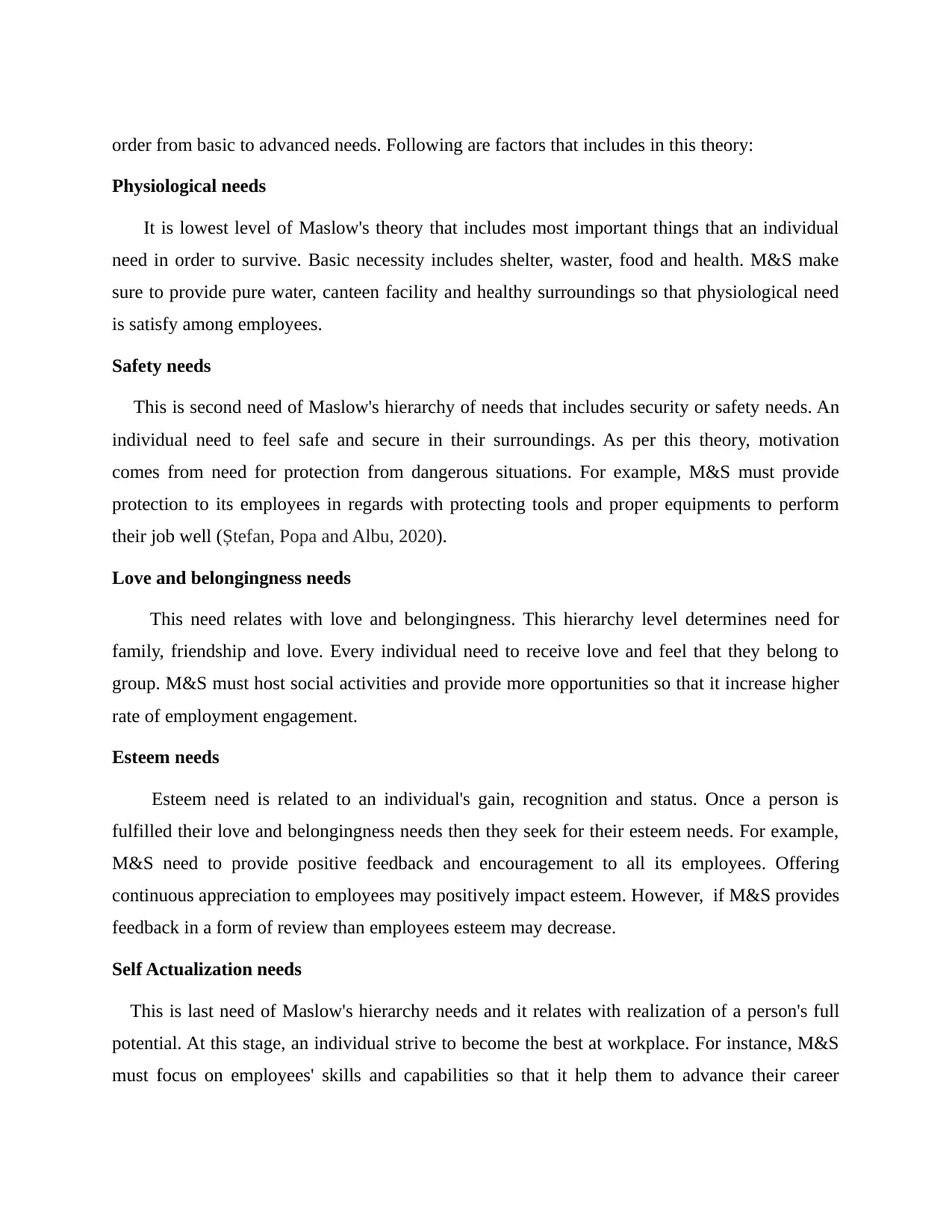
order from basic to advanced needs. Following are factors that includes in this theory:
Physiological needs
It is lowest level of Maslow's theory that includes most important things that an individual
need in order to survive. Basic necessity includes shelter, waster, food and health. M&S make
sure to provide pure water, canteen facility and healthy surroundings so that physiological need
is satisfy among employees.
Safety needs
This is second need of Maslow's hierarchy of needs that includes security or safety needs. An
individual need to feel safe and secure in their surroundings. As per this theory, motivation
comes from need for protection from dangerous situations. For example, M&S must provide
protection to its employees in regards with protecting tools and proper equipments to perform
their job well (Ștefan, Popa and Albu, 2020).
Love and belongingness needs
This need relates with love and belongingness. This hierarchy level determines need for
family, friendship and love. Every individual need to receive love and feel that they belong to
group. M&S must host social activities and provide more opportunities so that it increase higher
rate of employment engagement.
Esteem needs
Esteem need is related to an individual's gain, recognition and status. Once a person is
fulfilled their love and belongingness needs then they seek for their esteem needs. For example,
M&S need to provide positive feedback and encouragement to all its employees. Offering
continuous appreciation to employees may positively impact esteem. However, if M&S provides
feedback in a form of review than employees esteem may decrease.
Self Actualization needs
This is last need of Maslow's hierarchy needs and it relates with realization of a person's full
potential. At this stage, an individual strive to become the best at workplace. For instance, M&S
must focus on employees' skills and capabilities so that it help them to advance their career
Physiological needs
It is lowest level of Maslow's theory that includes most important things that an individual
need in order to survive. Basic necessity includes shelter, waster, food and health. M&S make
sure to provide pure water, canteen facility and healthy surroundings so that physiological need
is satisfy among employees.
Safety needs
This is second need of Maslow's hierarchy of needs that includes security or safety needs. An
individual need to feel safe and secure in their surroundings. As per this theory, motivation
comes from need for protection from dangerous situations. For example, M&S must provide
protection to its employees in regards with protecting tools and proper equipments to perform
their job well (Ștefan, Popa and Albu, 2020).
Love and belongingness needs
This need relates with love and belongingness. This hierarchy level determines need for
family, friendship and love. Every individual need to receive love and feel that they belong to
group. M&S must host social activities and provide more opportunities so that it increase higher
rate of employment engagement.
Esteem needs
Esteem need is related to an individual's gain, recognition and status. Once a person is
fulfilled their love and belongingness needs then they seek for their esteem needs. For example,
M&S need to provide positive feedback and encouragement to all its employees. Offering
continuous appreciation to employees may positively impact esteem. However, if M&S provides
feedback in a form of review than employees esteem may decrease.
Self Actualization needs
This is last need of Maslow's hierarchy needs and it relates with realization of a person's full
potential. At this stage, an individual strive to become the best at workplace. For instance, M&S
must focus on employees' skills and capabilities so that it help them to advance their career
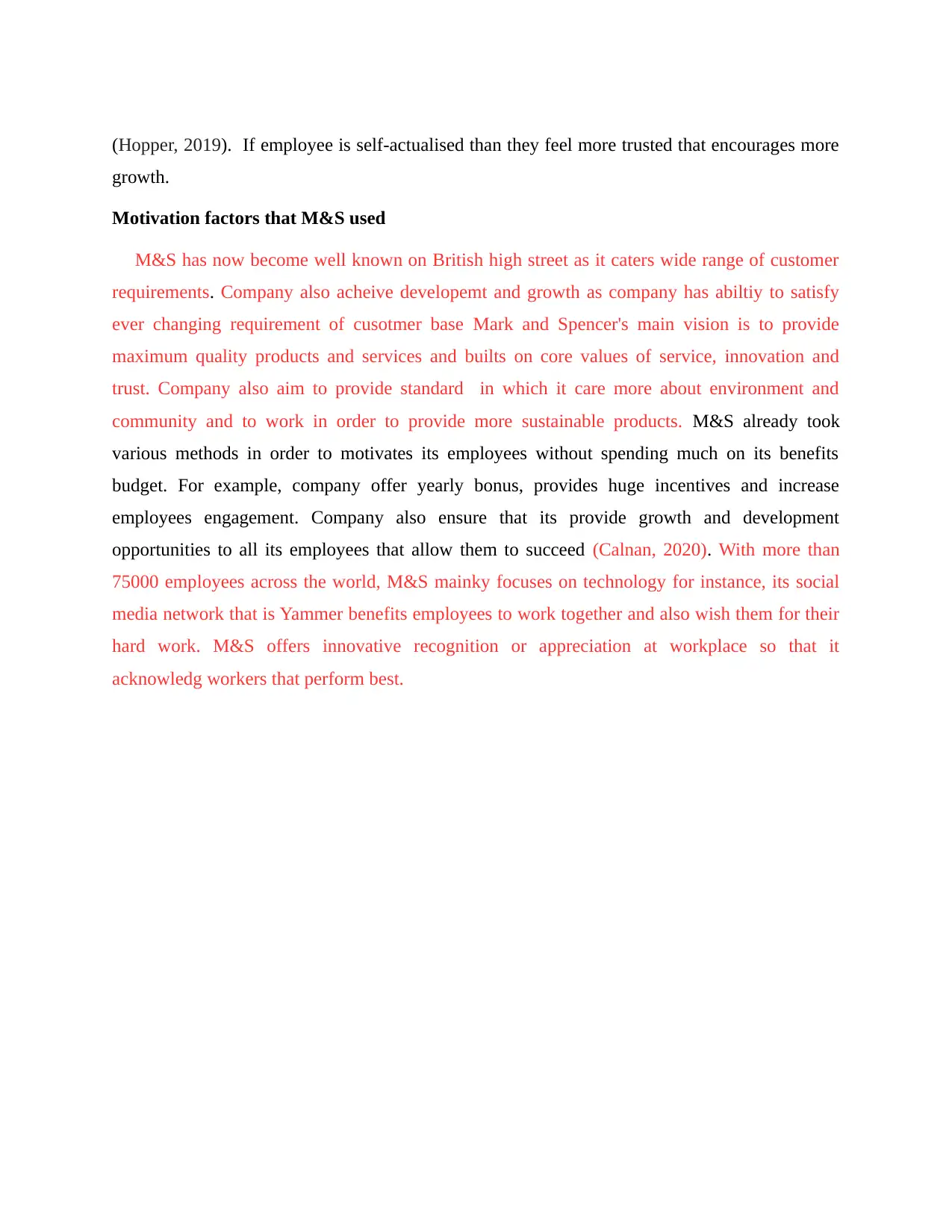
(Hopper, 2019). If employee is self-actualised than they feel more trusted that encourages more
growth.
Motivation factors that M&S used
M&S has now become well known on British high street as it caters wide range of customer
requirements. Company also acheive developemt and growth as company has abiltiy to satisfy
ever changing requirement of cusotmer base Mark and Spencer's main vision is to provide
maximum quality products and services and builts on core values of service, innovation and
trust. Company also aim to provide standard in which it care more about environment and
community and to work in order to provide more sustainable products. M&S already took
various methods in order to motivates its employees without spending much on its benefits
budget. For example, company offer yearly bonus, provides huge incentives and increase
employees engagement. Company also ensure that its provide growth and development
opportunities to all its employees that allow them to succeed (Calnan, 2020). With more than
75000 employees across the world, M&S mainky focuses on technology for instance, its social
media network that is Yammer benefits employees to work together and also wish them for their
hard work. M&S offers innovative recognition or appreciation at workplace so that it
acknowledg workers that perform best.
growth.
Motivation factors that M&S used
M&S has now become well known on British high street as it caters wide range of customer
requirements. Company also acheive developemt and growth as company has abiltiy to satisfy
ever changing requirement of cusotmer base Mark and Spencer's main vision is to provide
maximum quality products and services and builts on core values of service, innovation and
trust. Company also aim to provide standard in which it care more about environment and
community and to work in order to provide more sustainable products. M&S already took
various methods in order to motivates its employees without spending much on its benefits
budget. For example, company offer yearly bonus, provides huge incentives and increase
employees engagement. Company also ensure that its provide growth and development
opportunities to all its employees that allow them to succeed (Calnan, 2020). With more than
75000 employees across the world, M&S mainky focuses on technology for instance, its social
media network that is Yammer benefits employees to work together and also wish them for their
hard work. M&S offers innovative recognition or appreciation at workplace so that it
acknowledg workers that perform best.
⊘ This is a preview!⊘
Do you want full access?
Subscribe today to unlock all pages.

Trusted by 1+ million students worldwide
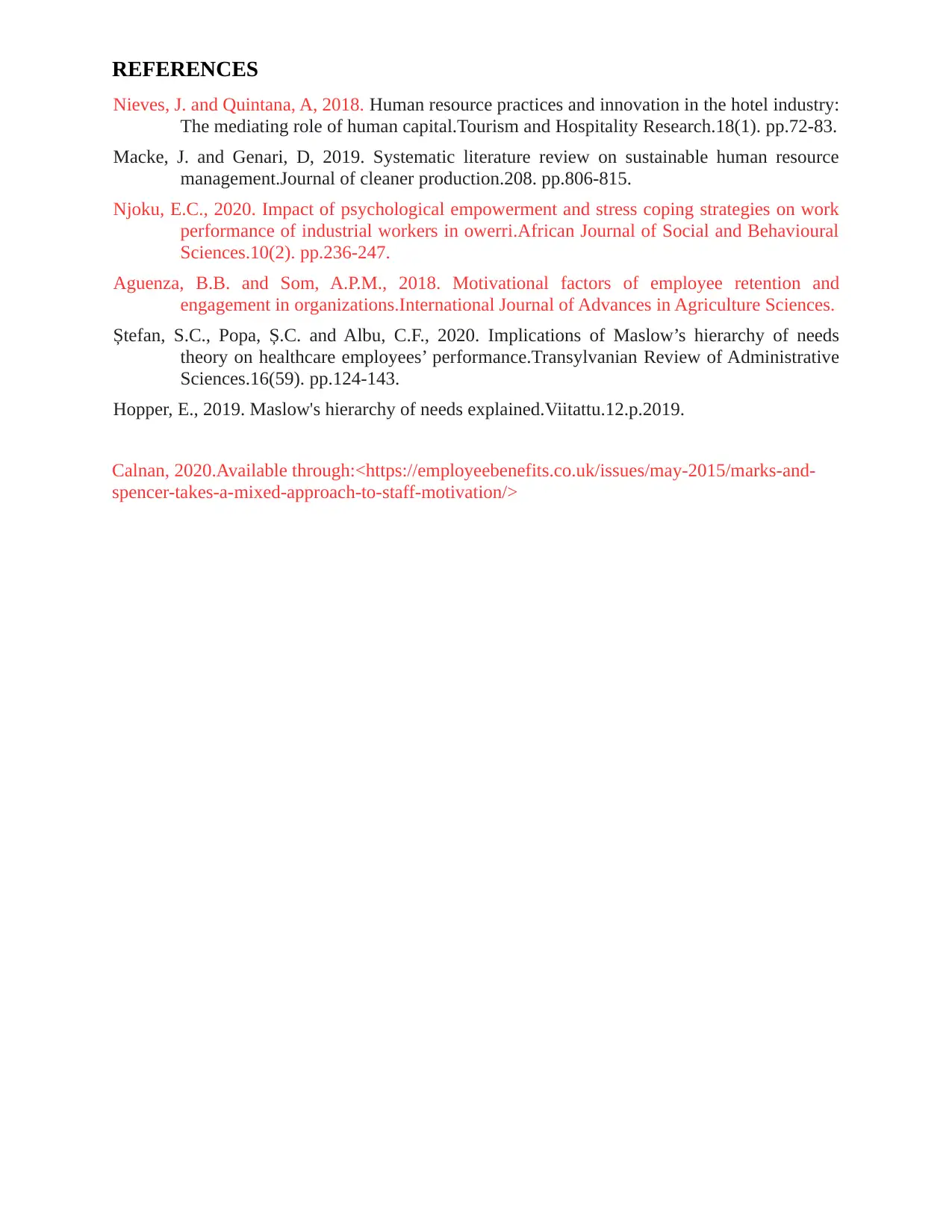
REFERENCES
Nieves, J. and Quintana, A, 2018. Human resource practices and innovation in the hotel industry:
The mediating role of human capital.Tourism and Hospitality Research.18(1). pp.72-83.
Macke, J. and Genari, D, 2019. Systematic literature review on sustainable human resource
management.Journal of cleaner production.208. pp.806-815.
Njoku, E.C., 2020. Impact of psychological empowerment and stress coping strategies on work
performance of industrial workers in owerri.African Journal of Social and Behavioural
Sciences.10(2). pp.236-247.
Aguenza, B.B. and Som, A.P.M., 2018. Motivational factors of employee retention and
engagement in organizations.International Journal of Advances in Agriculture Sciences.
Ștefan, S.C., Popa, Ș.C. and Albu, C.F., 2020. Implications of Maslow’s hierarchy of needs
theory on healthcare employees’ performance.Transylvanian Review of Administrative
Sciences.16(59). pp.124-143.
Hopper, E., 2019. Maslow's hierarchy of needs explained.Viitattu.12.p.2019.
Calnan, 2020.Available through:<https://employeebenefits.co.uk/issues/may-2015/marks-and-
spencer-takes-a-mixed-approach-to-staff-motivation/>
Nieves, J. and Quintana, A, 2018. Human resource practices and innovation in the hotel industry:
The mediating role of human capital.Tourism and Hospitality Research.18(1). pp.72-83.
Macke, J. and Genari, D, 2019. Systematic literature review on sustainable human resource
management.Journal of cleaner production.208. pp.806-815.
Njoku, E.C., 2020. Impact of psychological empowerment and stress coping strategies on work
performance of industrial workers in owerri.African Journal of Social and Behavioural
Sciences.10(2). pp.236-247.
Aguenza, B.B. and Som, A.P.M., 2018. Motivational factors of employee retention and
engagement in organizations.International Journal of Advances in Agriculture Sciences.
Ștefan, S.C., Popa, Ș.C. and Albu, C.F., 2020. Implications of Maslow’s hierarchy of needs
theory on healthcare employees’ performance.Transylvanian Review of Administrative
Sciences.16(59). pp.124-143.
Hopper, E., 2019. Maslow's hierarchy of needs explained.Viitattu.12.p.2019.
Calnan, 2020.Available through:<https://employeebenefits.co.uk/issues/may-2015/marks-and-
spencer-takes-a-mixed-approach-to-staff-motivation/>
Paraphrase This Document
Need a fresh take? Get an instant paraphrase of this document with our AI Paraphraser
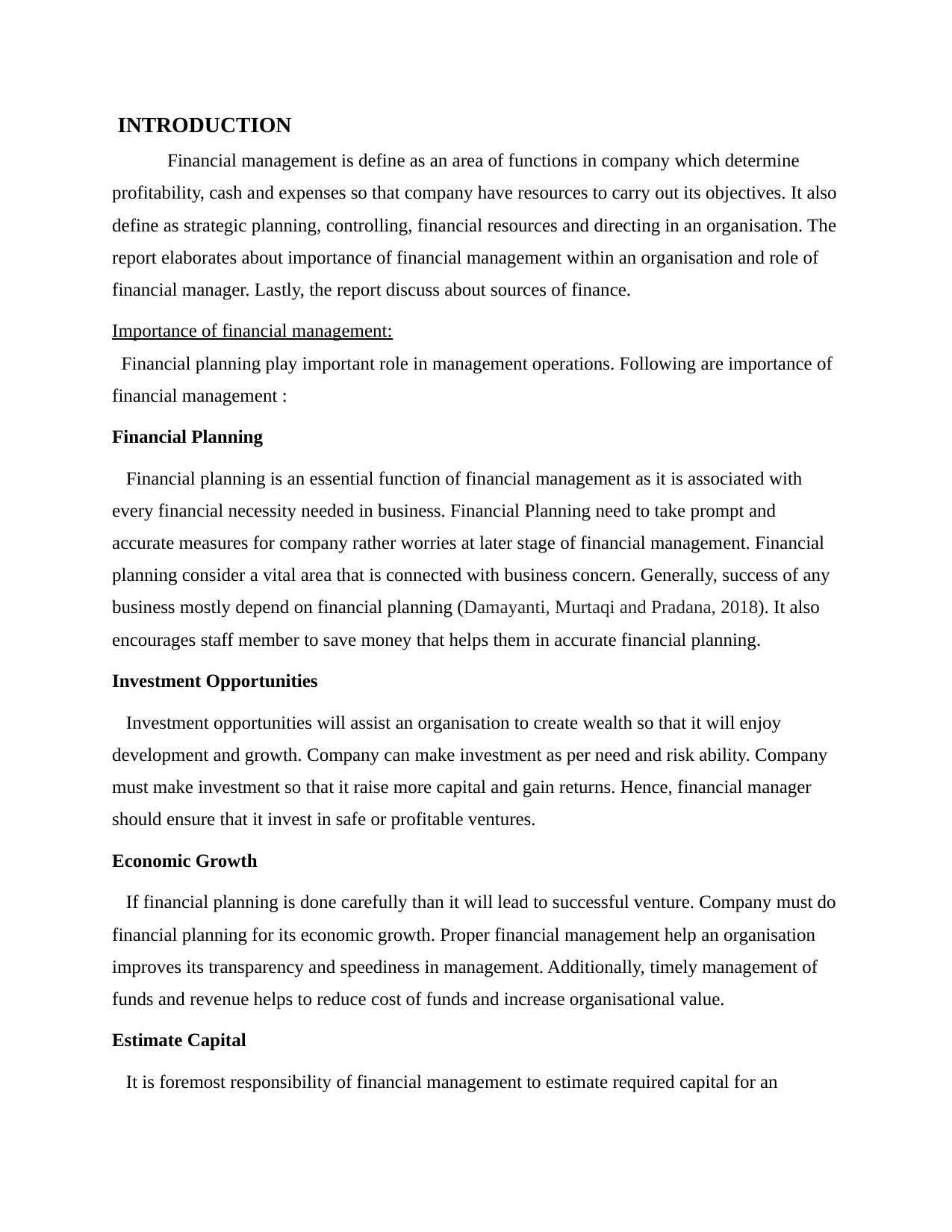
INTRODUCTION
Financial management is define as an area of functions in company which determine
profitability, cash and expenses so that company have resources to carry out its objectives. It also
define as strategic planning, controlling, financial resources and directing in an organisation. The
report elaborates about importance of financial management within an organisation and role of
financial manager. Lastly, the report discuss about sources of finance.
Importance of financial management:
Financial planning play important role in management operations. Following are importance of
financial management :
Financial Planning
Financial planning is an essential function of financial management as it is associated with
every financial necessity needed in business. Financial Planning need to take prompt and
accurate measures for company rather worries at later stage of financial management. Financial
planning consider a vital area that is connected with business concern. Generally, success of any
business mostly depend on financial planning (Damayanti, Murtaqi and Pradana, 2018). It also
encourages staff member to save money that helps them in accurate financial planning.
Investment Opportunities
Investment opportunities will assist an organisation to create wealth so that it will enjoy
development and growth. Company can make investment as per need and risk ability. Company
must make investment so that it raise more capital and gain returns. Hence, financial manager
should ensure that it invest in safe or profitable ventures.
Economic Growth
If financial planning is done carefully than it will lead to successful venture. Company must do
financial planning for its economic growth. Proper financial management help an organisation
improves its transparency and speediness in management. Additionally, timely management of
funds and revenue helps to reduce cost of funds and increase organisational value.
Estimate Capital
It is foremost responsibility of financial management to estimate required capital for an
Financial management is define as an area of functions in company which determine
profitability, cash and expenses so that company have resources to carry out its objectives. It also
define as strategic planning, controlling, financial resources and directing in an organisation. The
report elaborates about importance of financial management within an organisation and role of
financial manager. Lastly, the report discuss about sources of finance.
Importance of financial management:
Financial planning play important role in management operations. Following are importance of
financial management :
Financial Planning
Financial planning is an essential function of financial management as it is associated with
every financial necessity needed in business. Financial Planning need to take prompt and
accurate measures for company rather worries at later stage of financial management. Financial
planning consider a vital area that is connected with business concern. Generally, success of any
business mostly depend on financial planning (Damayanti, Murtaqi and Pradana, 2018). It also
encourages staff member to save money that helps them in accurate financial planning.
Investment Opportunities
Investment opportunities will assist an organisation to create wealth so that it will enjoy
development and growth. Company can make investment as per need and risk ability. Company
must make investment so that it raise more capital and gain returns. Hence, financial manager
should ensure that it invest in safe or profitable ventures.
Economic Growth
If financial planning is done carefully than it will lead to successful venture. Company must do
financial planning for its economic growth. Proper financial management help an organisation
improves its transparency and speediness in management. Additionally, timely management of
funds and revenue helps to reduce cost of funds and increase organisational value.
Estimate Capital
It is foremost responsibility of financial management to estimate required capital for an
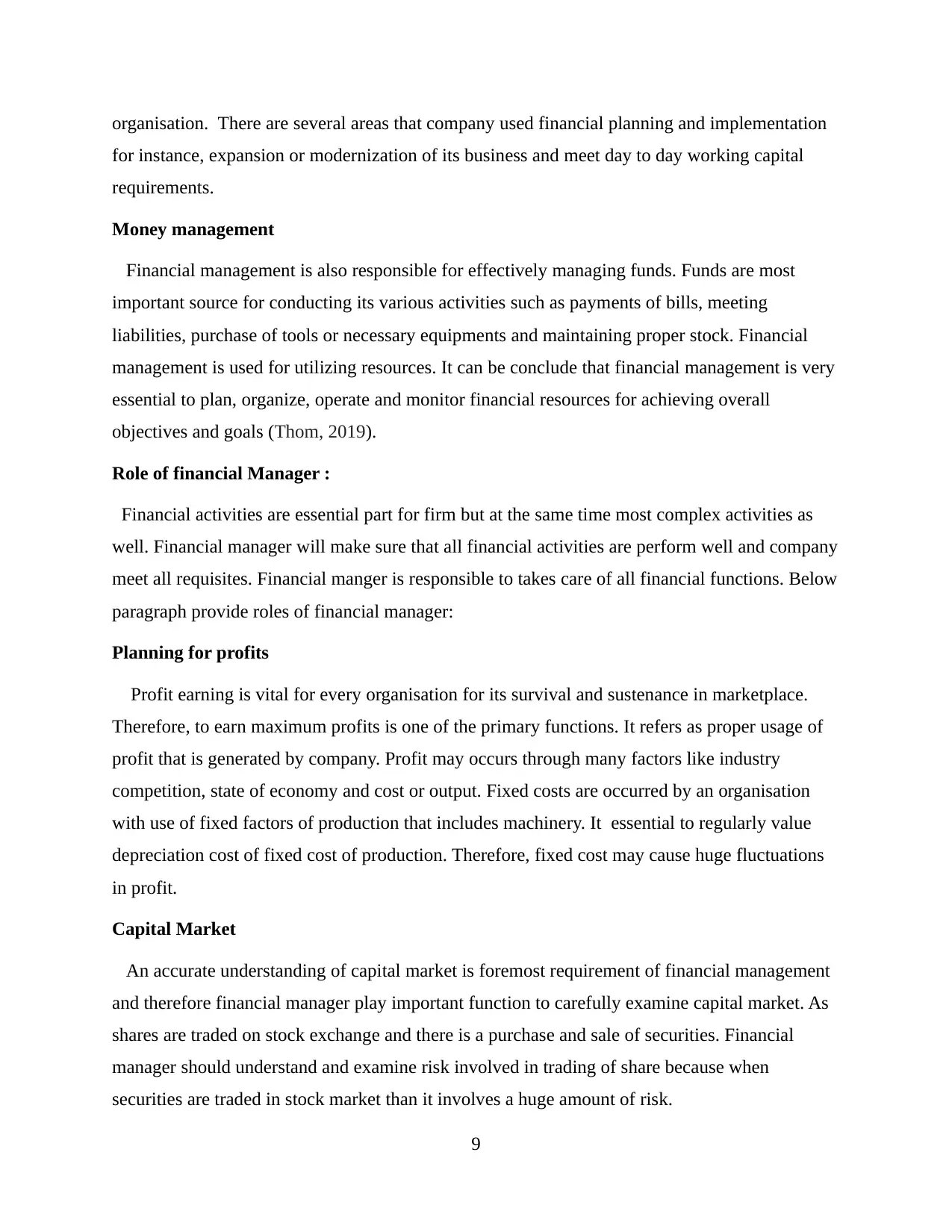
organisation. There are several areas that company used financial planning and implementation
for instance, expansion or modernization of its business and meet day to day working capital
requirements.
Money management
Financial management is also responsible for effectively managing funds. Funds are most
important source for conducting its various activities such as payments of bills, meeting
liabilities, purchase of tools or necessary equipments and maintaining proper stock. Financial
management is used for utilizing resources. It can be conclude that financial management is very
essential to plan, organize, operate and monitor financial resources for achieving overall
objectives and goals (Thom, 2019).
Role of financial Manager :
Financial activities are essential part for firm but at the same time most complex activities as
well. Financial manager will make sure that all financial activities are perform well and company
meet all requisites. Financial manger is responsible to takes care of all financial functions. Below
paragraph provide roles of financial manager:
Planning for profits
Profit earning is vital for every organisation for its survival and sustenance in marketplace.
Therefore, to earn maximum profits is one of the primary functions. It refers as proper usage of
profit that is generated by company. Profit may occurs through many factors like industry
competition, state of economy and cost or output. Fixed costs are occurred by an organisation
with use of fixed factors of production that includes machinery. It essential to regularly value
depreciation cost of fixed cost of production. Therefore, fixed cost may cause huge fluctuations
in profit.
Capital Market
An accurate understanding of capital market is foremost requirement of financial management
and therefore financial manager play important function to carefully examine capital market. As
shares are traded on stock exchange and there is a purchase and sale of securities. Financial
manager should understand and examine risk involved in trading of share because when
securities are traded in stock market than it involves a huge amount of risk.
9
for instance, expansion or modernization of its business and meet day to day working capital
requirements.
Money management
Financial management is also responsible for effectively managing funds. Funds are most
important source for conducting its various activities such as payments of bills, meeting
liabilities, purchase of tools or necessary equipments and maintaining proper stock. Financial
management is used for utilizing resources. It can be conclude that financial management is very
essential to plan, organize, operate and monitor financial resources for achieving overall
objectives and goals (Thom, 2019).
Role of financial Manager :
Financial activities are essential part for firm but at the same time most complex activities as
well. Financial manager will make sure that all financial activities are perform well and company
meet all requisites. Financial manger is responsible to takes care of all financial functions. Below
paragraph provide roles of financial manager:
Planning for profits
Profit earning is vital for every organisation for its survival and sustenance in marketplace.
Therefore, to earn maximum profits is one of the primary functions. It refers as proper usage of
profit that is generated by company. Profit may occurs through many factors like industry
competition, state of economy and cost or output. Fixed costs are occurred by an organisation
with use of fixed factors of production that includes machinery. It essential to regularly value
depreciation cost of fixed cost of production. Therefore, fixed cost may cause huge fluctuations
in profit.
Capital Market
An accurate understanding of capital market is foremost requirement of financial management
and therefore financial manager play important function to carefully examine capital market. As
shares are traded on stock exchange and there is a purchase and sale of securities. Financial
manager should understand and examine risk involved in trading of share because when
securities are traded in stock market than it involves a huge amount of risk.
9
⊘ This is a preview!⊘
Do you want full access?
Subscribe today to unlock all pages.

Trusted by 1+ million students worldwide
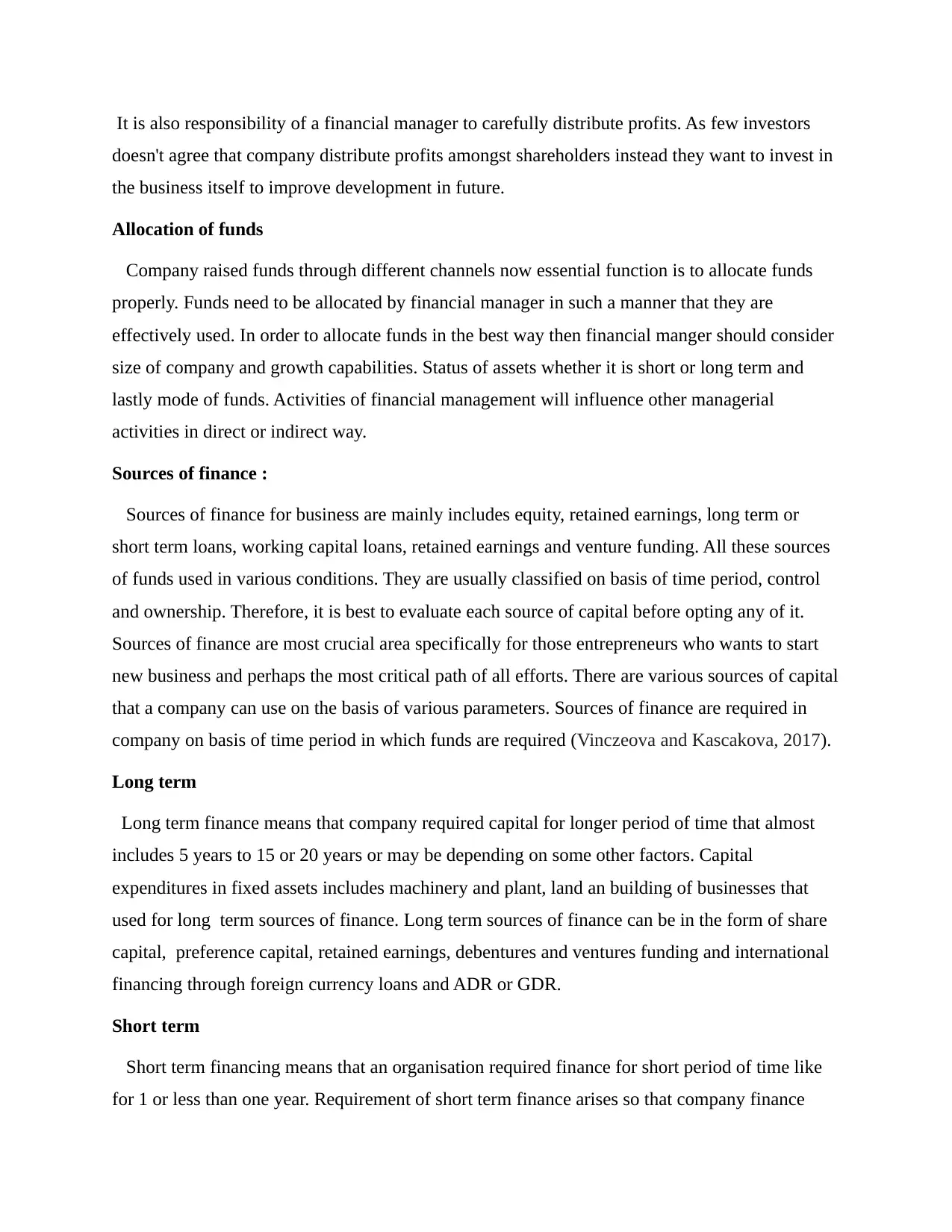
It is also responsibility of a financial manager to carefully distribute profits. As few investors
doesn't agree that company distribute profits amongst shareholders instead they want to invest in
the business itself to improve development in future.
Allocation of funds
Company raised funds through different channels now essential function is to allocate funds
properly. Funds need to be allocated by financial manager in such a manner that they are
effectively used. In order to allocate funds in the best way then financial manger should consider
size of company and growth capabilities. Status of assets whether it is short or long term and
lastly mode of funds. Activities of financial management will influence other managerial
activities in direct or indirect way.
Sources of finance :
Sources of finance for business are mainly includes equity, retained earnings, long term or
short term loans, working capital loans, retained earnings and venture funding. All these sources
of funds used in various conditions. They are usually classified on basis of time period, control
and ownership. Therefore, it is best to evaluate each source of capital before opting any of it.
Sources of finance are most crucial area specifically for those entrepreneurs who wants to start
new business and perhaps the most critical path of all efforts. There are various sources of capital
that a company can use on the basis of various parameters. Sources of finance are required in
company on basis of time period in which funds are required (Vinczeova and Kascakova, 2017).
Long term
Long term finance means that company required capital for longer period of time that almost
includes 5 years to 15 or 20 years or may be depending on some other factors. Capital
expenditures in fixed assets includes machinery and plant, land an building of businesses that
used for long term sources of finance. Long term sources of finance can be in the form of share
capital, preference capital, retained earnings, debentures and ventures funding and international
financing through foreign currency loans and ADR or GDR.
Short term
Short term financing means that an organisation required finance for short period of time like
for 1 or less than one year. Requirement of short term finance arises so that company finance
doesn't agree that company distribute profits amongst shareholders instead they want to invest in
the business itself to improve development in future.
Allocation of funds
Company raised funds through different channels now essential function is to allocate funds
properly. Funds need to be allocated by financial manager in such a manner that they are
effectively used. In order to allocate funds in the best way then financial manger should consider
size of company and growth capabilities. Status of assets whether it is short or long term and
lastly mode of funds. Activities of financial management will influence other managerial
activities in direct or indirect way.
Sources of finance :
Sources of finance for business are mainly includes equity, retained earnings, long term or
short term loans, working capital loans, retained earnings and venture funding. All these sources
of funds used in various conditions. They are usually classified on basis of time period, control
and ownership. Therefore, it is best to evaluate each source of capital before opting any of it.
Sources of finance are most crucial area specifically for those entrepreneurs who wants to start
new business and perhaps the most critical path of all efforts. There are various sources of capital
that a company can use on the basis of various parameters. Sources of finance are required in
company on basis of time period in which funds are required (Vinczeova and Kascakova, 2017).
Long term
Long term finance means that company required capital for longer period of time that almost
includes 5 years to 15 or 20 years or may be depending on some other factors. Capital
expenditures in fixed assets includes machinery and plant, land an building of businesses that
used for long term sources of finance. Long term sources of finance can be in the form of share
capital, preference capital, retained earnings, debentures and ventures funding and international
financing through foreign currency loans and ADR or GDR.
Short term
Short term financing means that an organisation required finance for short period of time like
for 1 or less than one year. Requirement of short term finance arises so that company finance
Paraphrase This Document
Need a fresh take? Get an instant paraphrase of this document with our AI Paraphraser

current assets that includes stock of raw materials or finished goods, minimum amount of bank
or cash balance and debtors etc. Short financial also refereed as working capital financing. The
following are short term finances that are available in form of creditors, payables, advances
received from customers, factoring services and fixed deposits for less than one year. Sources of
finance is classified on basis of ownership or control of business (Oseifuah, 2017).
11
or cash balance and debtors etc. Short financial also refereed as working capital financing. The
following are short term finances that are available in form of creditors, payables, advances
received from customers, factoring services and fixed deposits for less than one year. Sources of
finance is classified on basis of ownership or control of business (Oseifuah, 2017).
11
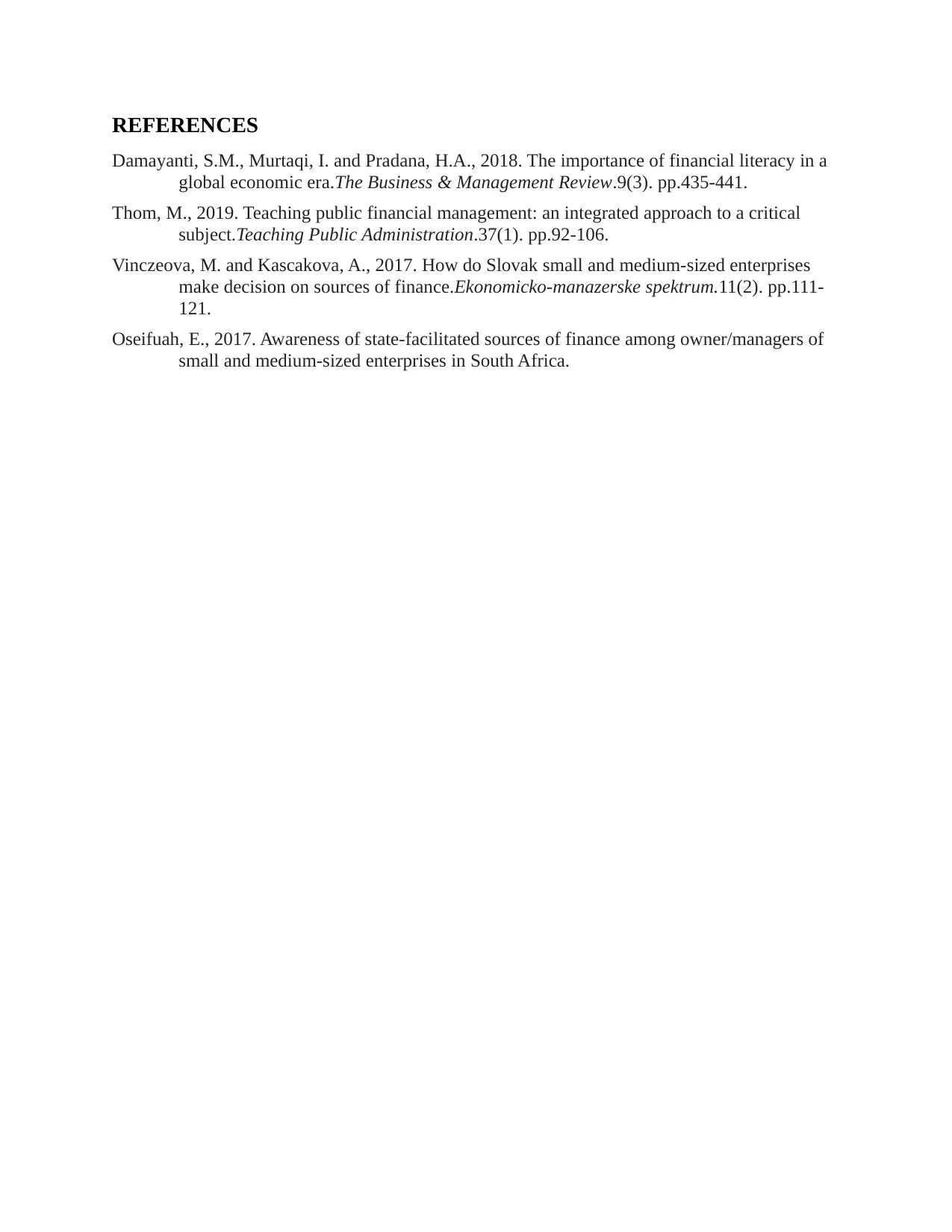
REFERENCES
Damayanti, S.M., Murtaqi, I. and Pradana, H.A., 2018. The importance of financial literacy in a
global economic era.The Business & Management Review.9(3). pp.435-441.
Thom, M., 2019. Teaching public financial management: an integrated approach to a critical
subject.Teaching Public Administration.37(1). pp.92-106.
Vinczeova, M. and Kascakova, A., 2017. How do Slovak small and medium-sized enterprises
make decision on sources of finance.Ekonomicko-manazerske spektrum.11(2). pp.111-
121.
Oseifuah, E., 2017. Awareness of state-facilitated sources of finance among owner/managers of
small and medium-sized enterprises in South Africa.
Damayanti, S.M., Murtaqi, I. and Pradana, H.A., 2018. The importance of financial literacy in a
global economic era.The Business & Management Review.9(3). pp.435-441.
Thom, M., 2019. Teaching public financial management: an integrated approach to a critical
subject.Teaching Public Administration.37(1). pp.92-106.
Vinczeova, M. and Kascakova, A., 2017. How do Slovak small and medium-sized enterprises
make decision on sources of finance.Ekonomicko-manazerske spektrum.11(2). pp.111-
121.
Oseifuah, E., 2017. Awareness of state-facilitated sources of finance among owner/managers of
small and medium-sized enterprises in South Africa.
⊘ This is a preview!⊘
Do you want full access?
Subscribe today to unlock all pages.

Trusted by 1+ million students worldwide
1 out of 12
Related Documents
Your All-in-One AI-Powered Toolkit for Academic Success.
+13062052269
info@desklib.com
Available 24*7 on WhatsApp / Email
![[object Object]](/_next/static/media/star-bottom.7253800d.svg)
Unlock your academic potential
Copyright © 2020–2025 A2Z Services. All Rights Reserved. Developed and managed by ZUCOL.





